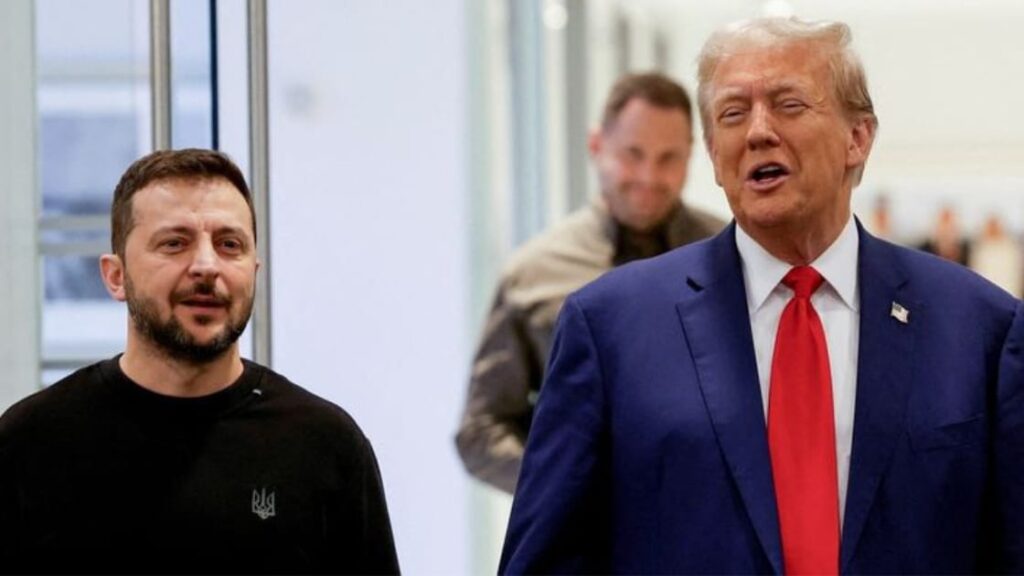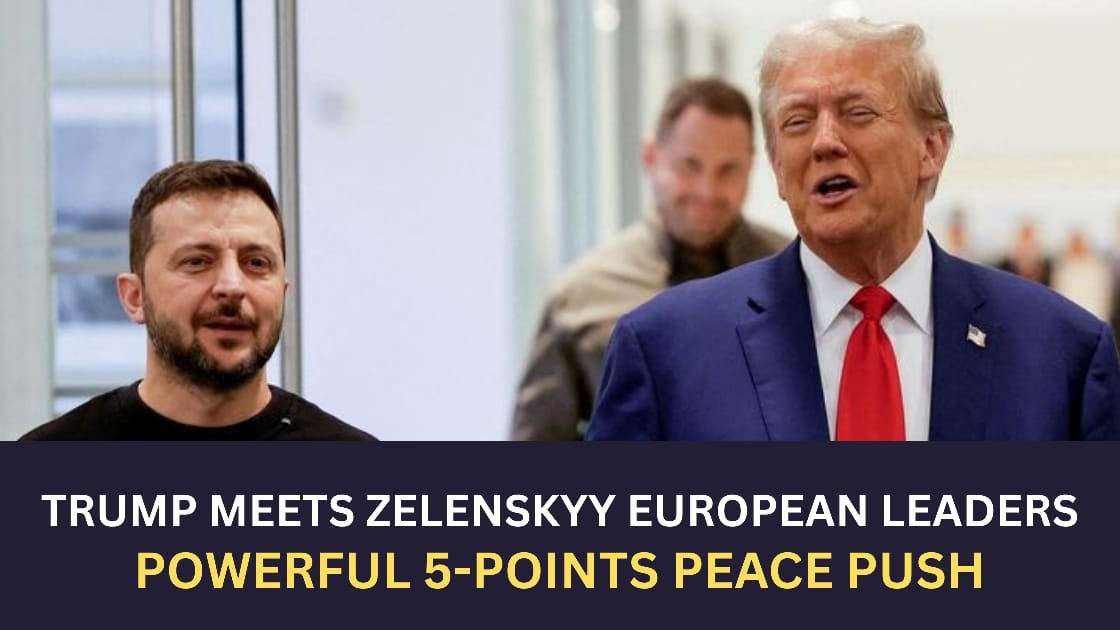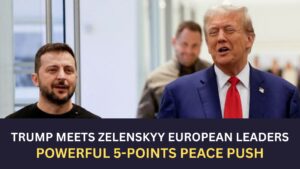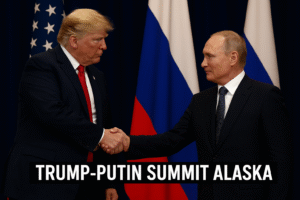Introduction
Trump meets Zelensky European leaders at the White House in a pivotal attempt to change the momentum of the war in Ukraine. On August 18, 2025, U.S. President Donald Trump hosted Ukrainian President Volodymyr Zelenskyy alongside key European leaders for an intensive summit that blended diplomacy, pressure, and high-stakes strategy.
The central themes of the talks revolved around Ukraine security guarantees, potential ceasefire negotiations, and whether a trilateral summit plan including Russian President Vladimir Putin could open the door to peace. The shadow looming over the discussions, however, was the fear of territorial concessions concerns, with Kyiv and its European allies cautious about any deal that might weaken Ukraine’s sovereignty.

Who Attended and Why It Matters
The summit brought together an unusually large number of international heavyweights. Alongside Trump and Zelenskyy were:
- French President Emmanuel Macron
- German Chancellor Friedrich Merz
- UK Prime Minister Keir Starmer
- Italian Prime Minister Giorgia Meloni
- Finnish President Alexander Stubb
- NATO Secretary-General Mark Rutte
- European Commission President Ursula von der Leyen
This diverse lineup underscored Europe’s determination to remain directly engaged in shaping the conflict’s outcome. According to reports from TIME and Indiatimes, European leaders wanted to avoid being sidelined if Washington and Moscow struck bilateral terms.
For Zelenskyy, the gathering was an opportunity to secure backing against any potential U.S.-Russia deal that might compromise Kyiv’s independence. The symbolism of standing shoulder to shoulder with Europe at the White House was not lost on observers. also read Trump-Putin Summit in Alaska
Security Guarantees Momentum
The primary issue on the table was Ukraine security guarantees. While NATO membership remains politically and logistically out of reach, both Trump and European leaders floated an alternative framework resembling NATO’s Article 5—promises of collective defense in case of future attacks.
Trump said the U.S. would provide “very good protection,” signaling Washington’s readiness to backstop Ukraine without dragging NATO into direct war. According to The Washington Post, discussions included advanced air defense systems, long-range missile support, and enhanced intelligence sharing.
Zelenskyy made it clear that Ukraine cannot accept any ceasefire or peace plan unless anchored in enforceable guarantees. Without them, he argued, any pause in fighting would merely give Russia time to regroup. As he put it during a press conference:
“Peace without protection is not peace. It is only a pause before the next aggression.”
European leaders supported his stance, insisting that a credible guarantee system is non-negotiable.
Ceasefire Standoff
The sharpest division appeared over ceasefire negotiations. Germany’s Friedrich Merz declared bluntly, “I can’t imagine that the next meeting will take place without a ceasefire.” France and Italy echoed the view, stressing that halting the bloodshed is the first step toward diplomacy.
Trump, however, suggested that while a ceasefire was desirable, it should not be a precondition for talks with Putin. His camp argued that insisting on a total ceasefire might delay progress indefinitely.
Zelenskyy sided with the Europeans. He insisted that negotiating while bombs are still falling on cities like Kharkiv and Zaporizhzhia is politically and morally impossible. Reports from The Times highlighted Zelenskyy’s pointed warning: “We will not bargain while our people are dying.”
This divergence highlighted the tightrope Zelenskyy must walk: accepting U.S. leadership while relying on European solidarity to hold the line on red-line conditions.
Trilateral Summit Prospects
Perhaps the most dramatic element of the summit was Trump’s announcement of a possible trilateral summit plan involving himself, Zelenskyy, and Putin within the next two weeks. Neutral venues such as Geneva or Vienna were reportedly under discussion.
According to The Guardian, Trump personally phoned Putin after the White House meeting to explore the idea. His administration hopes that direct, leader-to-leader diplomacy could yield breakthroughs where formal negotiations have stalled.
European officials were more cautious. Macron and Starmer in particular stressed that without a ceasefire, such a summit risks legitimizing continued Russian offensives. Zelenskyy himself avoided rejecting the idea but reiterated that Ukraine will not accept pressure to concede territory.
Territorial Concessions Concerns
The most controversial backdrop to the summit involves reports of potential territorial concessions concerns raised in back-channel Trump-Putin contacts. Speculation centered on whether Russia might retain parts of Donetsk, Luhansk, or Crimea in exchange for broader peace.
Such scenarios alarmed Kyiv and Europe alike. As Barron’s reported, even whispers of “land for peace” risk undermining Western unity. Zelenskyy responded firmly:
“No president of Ukraine has the authority to give away our land. Not in Donetsk, not in Luhansk, not in Crimea. Ukraine’s borders are not for sale.”
European leaders backed him. The fear is that any concessions could embolden Russia, setting a precedent for further aggression in the region.
The Role of European Unity
A striking theme was Europe’s growing cohesion. Despite differences in emphasis—Germany pushing hardest for a ceasefire, Britain insisting on military firmness—the European bloc presented a united front on rejecting territorial concessions and supporting security guarantees.
This unity matters because Europe bears the brunt of the war’s refugee flows, energy disruptions, and security risks. By appearing alongside Trump, European leaders ensured they were not passive spectators but active shapers of the process.
The U.S. Balancing Act
For Trump, the challenge is balancing domestic political pressures with international responsibilities. His administration faces critics who argue that endless aid to Ukraine drains U.S. resources. At the same time, Trump does not want to be seen as abandoning Ukraine or yielding to Putin.
His rhetoric of “flexibility” toward Russia while promising “protection” for Ukraine reflects this balancing act. Analysts warn, however, that mixed signals could weaken Western leverage if Moscow interprets them as cracks in unity.
Ukraine’s Strategic Red Lines
For Zelenskyy, the summit was both an opportunity and a test. He secured strong verbal backing for Ukraine security guarantees and avoided being cornered into accepting premature ceasefire negotiations. Yet, he must manage expectations at home, where public opinion overwhelmingly rejects territorial concessions.
Ukraine’s red lines remain clear: no recognition of Russia’s annexations, no negotiations without a ceasefire, and no peace without enforceable security guarantees. These positions, while firm, leave little room for compromise—raising questions about how diplomacy can advance without fundamental shifts on Russia’s side.
Global Implications Beyond Europe
The implications of this summit stretch far beyond Europe.
- China is closely monitoring whether Western unity holds, as it calculates its own posture on Taiwan.
- Global energy markets remain volatile, with oil prices fluctuating on every rumor of progress or breakdown in Ukraine talks.
- Developing countries in Africa and Asia, already hit by grain shortages, are pressing for a resolution to ensure stable food supplies.
In short, the stakes of Trump meets Zelenskyy European leaders extend well beyond the battlefield—touching economics, geopolitics, and the credibility of international law.
What’s Next
Looking ahead, several developments are expected:
- Security Package: Reports suggest Ukraine could soon receive a $90–100 billion arms and defense procurement package.
- Ceasefire Prerequisite: Europe continues to insist no major summit with Putin can occur without a ceasefire.
- Summit Venues: Geneva and Vienna remain top contenders for a trilateral meeting.
- Russian Escalation: Fresh attacks on Kharkiv and Zaporizhzhia show Moscow intends to negotiate from a position of strength.
- Public Messaging: Both Trump and Zelenskyy face the delicate task of managing domestic audiences while keeping diplomatic channels open.
Conclusion
The White House summit was not just another diplomatic meeting—it was a defining moment in the unfolding Russo-Ukrainian conflict. Trump meets Zelenskyy European leaders highlighted renewed efforts to craft Ukraine security guarantees, debates over ceasefire negotiations, the possibility of a trilateral summit plan, and unified rejection of territorial concessions concerns.
While no breakthroughs were announced, the gathering demonstrated that the transatlantic alliance remains committed to Ukraine’s sovereignty. Whether this momentum can translate into concrete progress—or whether divisions will resurface—will determine the trajectory of both the war and European security in the years ahead.







